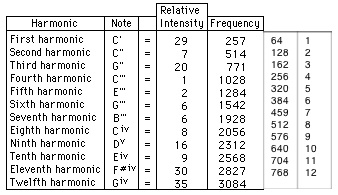Frequency difference between two tones or harmonics.

It is of interest to notice that the eleventh and twelfth harmonics, of frequencies 2827 and 3084 respectively, are both stronger than the fundamental note of frequency 257, and as the ear is many times more sensitive to notes of the higher frequencies than to notes of the lower, the sound which the ear perceives must consist almost entirely of tones of these higher frequencies. In other words, the eleventh and twelfth harmonics are composed almost entirely of beats of the lower frequencies. Thus the eleventh and twelfth harmonics are referred to as the "beat harmonics".
"Calling the intensity of the fundamental tone, in each case, 100, that of the second harmonic, when the string was simply pulled aside at a point 1/7th of its length from its end and then liberated, was found to be 56.1, or a little more than one-half. When the string was struck with the hammer of a pianoforte, whose contact with the string endured for 3/7ths of the period of vibration of the fundamental tone, the intensity of the same tone was 9. In this case the second harmonic was nearly quenched. When, however, the duration of contact was diminished to 3/20ths of the period of the fundamental, the intensity of the harmonic rose to 357; While, when the string was sharply struck with a very hard hammer, the intensity mounted to 505, or to more than quintuple that of the fundamental. (OVER UNITY X 5)
"Pianoforte manufacturers have found that the most pleasing tone is excited by the middle strings of their instruments, when the point against which the hammer strikes is from 1/7th to 1/9th of the length of the wire from its extremity. Why should this be the case? Helmhotz has given the answer. Up to the tones which require these points as nodes the overtones all form chords with the fundamental; but the sixth and eighth overtones of the wire do not enter into such chords; they are dissonant tones, and hence the desirability of doing away with them. This is accomplished by making the point at which a node is required that on which the hammer falls. The possibility of the tone forming is thereby shut out, and its injurious effect is avoided." [John Tyndall, Sound; Longmans, Green, and Co., London, 1893.]
Commentary
When looking at a circle of fifths chart the point with the most sharps and flats is usually depicted on the bottom of the circle where F# major has six sharps and Gb major has six flats. Now the wild thing is when comparing the Harmonic series to the Subharmonic series there is a point at which F# = Gb also. This is the triple octave plus the Augmented Fourth. This is the 11th harmonic and is a TRITONE setting up the peak Tension in the 4th octave of the Harmonic/Subharmonic serieses. In terms of a musical interval this 11th harmonic is called a Twenty-Fifth 11/1 ratio. [Zachary George Covell, 04/20/2017]
See Also
Additive and Subtractive Synthesis
Beat
Clang
constructive and deconstructive interference
Difference Tone
Differentiation
Overtones Developed Musically
Figure 8.5 - Summation Tones
Figure 8.6 - Difference Tones
Frequency Wavelength Light Energy
Harmonic
Heterodyne
Interval
Law of Harmonic Pitch
Law of Harmonic Vibrations
Overtone Series
Overtone
Resultant Tone
Summation Tone
Syntropy
Undertone
Vibrating Rod Harmonics
1.20 - Evolution and Devolution of Frequency
Power of Harmonics
9.8 - Spontaneous Creation of Harmonic Series
9.9 - Sympathy or Harmony Between Harmonics or Overtones
